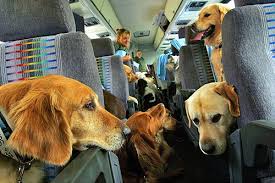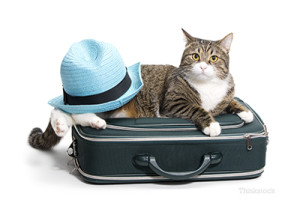With the holidays upon us it’s time to start thinking about what we’re going to do with our fuzzy family members as we head out to travel to friends and family. Traveling during the winter months with our pets by car, air, or even sea can bring some undue stressors to our dogs and cats. It’s The Vet Set’s goal to abate those hazards and stress with some education and planning. We’re going to divide this series into two sections – Travel by Air and Travel by Car.
Travel by Air
It’s no small decision to decide to fly with your pet. Whether you have your pet in the cabin with you or below in cargo there are many things that could expose your pet to stress and potential dangers. Pets with flat or smooshed faces (the medical term is bracycephalic and includes bulldogs, pugs, boxers, and Persian cats) are at higher risk for breathing problems and temperature fluctuations. Flying these pets in cargo can be life threatening.
Small dogs and ca ts should be flown in the cabin with you. Check with your airline to see if they allow pets in the cabin and their size restrictions. Some airlines only allow a set number of pet reservations per flight – so make your booking early! There are also airline specific regulations on the type of carrier your pet must be transported in requiring you to research which carrier is allowed. Your pet’s carrier will need to go through security just like your regular baggage. You will need to take your pet out of the carrier and hold her or request a private screening room where your pet can be securely removed and contained with you while the carrier is screened. The Vet Set recommends having a secure harness with attached ID tags regardless of what method you use. Give yourself lots of extra time so you’re not stressed!
ts should be flown in the cabin with you. Check with your airline to see if they allow pets in the cabin and their size restrictions. Some airlines only allow a set number of pet reservations per flight – so make your booking early! There are also airline specific regulations on the type of carrier your pet must be transported in requiring you to research which carrier is allowed. Your pet’s carrier will need to go through security just like your regular baggage. You will need to take your pet out of the carrier and hold her or request a private screening room where your pet can be securely removed and contained with you while the carrier is screened. The Vet Set recommends having a secure harness with attached ID tags regardless of what method you use. Give yourself lots of extra time so you’re not stressed!
The Question To Sedate
Sedation for your pet is a controversial topic for airline travel. In some instances when the pet is flying with you in the cabin I will recommend sedation. For the vast majority of pets flying in cargo I do not recommend sedation because if there was an emergency nobody would be there to monitor your pet. You can
 try natural remedies such as Rescue Remedy or Feliway for cats to help reduce anxiety. Training your pet to become familiar with her carrier or crate starting a month ahead of time is the best solution.
try natural remedies such as Rescue Remedy or Feliway for cats to help reduce anxiety. Training your pet to become familiar with her carrier or crate starting a month ahead of time is the best solution.
The Vet Set recommends withholding food starting 6 hours prior to the flight. If your pet is flying cargo add ice cubes to the dish to allow them to melt over time. A large water bowl will just spill creating a messy environment for your pet. For dogs traveling in the cabin more and more airports are creating pet areas for your pet to relieve themselves and to have a little water. Again, wait to feed your pet a full meal until you have arrived.
Flying Pets In Cargo Safety Tips
IF you must travel with your pet in cargo please read the following carefully. Winter and the holidays are an especially difficult time of the year with extreme weather, excessive amounts of baggage, and the propensity for delays. Again, if you don’t need to fly with your pet in cargo, please don’t.
The following is advice for flying with your pets in cargo from The Humane Society of the United States. Follow these tips to increase the chances for a safe flight..
- Use direct flights. You will avoid the mistakes that occur during airline transfers and possible delays in getting your pet off the plane.
- Always travel on the same flight as your pet.Ask the airline if you can watch your pet being loaded into the cargo hold and unloaded.
- When you board the plane, notify the captainand at least one flight attendant that your pet is traveling in the cargo hold. If the captain knows that pets are on board, he or she may take special precautions.
- Don’t ever ship brachycephalic animals such as Pekingese dogs, bulldogs or Persian cats in the cargo holds.
- If traveling during the summer or winter months, choose flights that will accommodate the temperature extremes. Early morning or late evening flights are better in the summer; afternoon flights are better in the winter.
- Fit your pet with a collar that can’t get caught in carrier doors.Affix two pieces of identification on the collar: a permanent ID with your name and home address and telephone number, and a temporary travel ID with the address and telephone number where you or a contact person can be reached.
- Affix a travel label to the carrieron which you’ve written your name, permanent address and telephone number, final destination, and where you or a contact person can be reached as soon as the flight arrives.
- Make sure that your pet’s nails have been clippedto protect against them getting hooked in the carrier’s door, holes, and other crevices.
- Give your pet at least a month before your flight to become familiar with the travel carrier. This will minimize his stress during travel.
- Do not give your pet tranquilizers unless they are prescribed by your veterinarian. Make sure your veterinarian understands that the prescription is for air travel.
- Do not feed your pet for four to six hours before the trip.However, you can give him small amounts of water. If possible, put ice cubes in the water tray attached to the inside of your pet’s crate or kennel. (A full water bowl will only spill and cause discomfort.)
- Try not to fly with your pet during busy travel times such as holidays and the summer. Your pet is more likely to undergo rough handling during hectic travel periods.
- Carry a current photograph of your pet. If your pet is lost during the trip, a photograph will make it much easier for airline employees to search effectively.
- When you arrive at your destination, open the carrier as soon as you are in a safe place and examine your pet.If anything seems wrong, take your pet to a veterinarian immediately. Get the results of the examination in writing, including the date and time.
Health Certificates
Most airlines require your pet to be examined by a USDA Accredited veterinarian and have a health certificate issued. An USDA Accredited veterinarian is a licensed veterinarian that has gone through additional training and certification to ensure the animal health and welfare of animals traveling in the United States and abroad. The veterinarians at The Vet Set have completed all training and maintain their accreditation meaning we can provide the APHIS 7001 health certificate you need to fly with your pet. If you are flying internationally The Vet Set will work with the local USDA veterinarian at large to help with the paperwork and certifications needed as dictated by each country. The Vet Set will help your jet setting pet get to her destination.
If You See Something, Say Something
If you’re traveling and you see mishandling of a pet report it right away to the manager of the area including time, place, and any photos you can submit. Twitter and Facebook are other forums you can use to quickly get the attention of the airline. Even if it’s not your pet you could be preventing a tragedy for that animal. We all need to lookout for those who can’t lookout for themselves.
Travel safe, and have a great holiday season!
